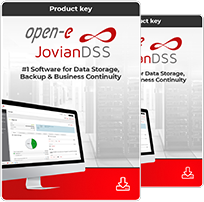NOTE:
Software Version: DSS ver.6.00 up40.
top ↑1. Replication Solutions Supported by Open-E DSS
| Replication Mode | Source/Destination | Data Transfer | Volume Type | ||||||||
| Synchro -nous | Asynchro -nous | w/ System | LAN | WAN | File based | Block based | NAS | iSCSI | FC | ||
| File-IO | Block-IO | ||||||||||
| Asynchronous Data Replication within a system | |||||||||||
| Asynchronous Data Replication over a LAN | |||||||||||
| Asynchronous Data Replication over a WAN | |||||||||||
| Synchronous Volume Replication over a LAN | |||||||||||
| Synchronous Volume Replication over a WAN | |||||||||||
| Synchronous Volume Replication with Failover over a LAN | |||||||||||
- Open-E DSS supports three different types of file based Data Replication
- Asynchronous Data Replication (file based) within the system
- Asynchronous Data Replication (file based) over a LAN
- Asynchronous Data Replication (file based) over a WAN
- Additionally, DSS Supports three types of block based Volume Replication
- Synchronous Volume Replication (block based) over a LAN for NAS, iSCSI and Fiber Channel appliances,
- Synchronous Volume Replication (block based) over a WAN for NAS, iSCSI and Fiber Channel appliances,
- Synchronous Volume Replication (block based) with Failover over a LAN for iSCSI appliances
top ↑2. Data Replications - Replication Solutions Supported by Open-E DSS
| Replication Mode | Source/Destination | Data Transfer | Volume Type | ||||||||
| Synchro -nous | Asynchro -nous | w/ System | LAN | WAN | File based | Block based | NAS | iSCSI | FC | ||
| File-IO | Block-IO | ||||||||||
| Asynchronous Data Replication within a system | |||||||||||
| Asynchronous Data Replication over a LAN | |||||||||||
| Asynchronous Data Replication over a WAN | |||||||||||
- Open-E Data Replication enables asynchronous file and folder copy from one storage system to another for maximum data availability.
- With Asynchronous Replication, a point-in-time snapshot copy of data on the source is made and copied to the target storage system.
- For maximum flexibility, you can run a data replication task in two directions: one system can be both the source and the destination at the same time, allowing cross data backups on several systems. Replication can be used in disaster recovery or for disk-to-disk backup.
top ↑2.1. Asynchronous Data Replication within a System
Replication between two RAID ARRAYs within one system
- Recommended Resources
- Key Hardware
- x86 compatible
- RAID Controller 1
- RAID Controller 2
- HDD's
- Network Interface Cards
- Software
- Open-E DSS
- Key Hardware
- Benefits
- Data redundancy over RAID Array
- Local data availability
- Low cost solution
- Disadvantages
- In case of complete system failure, data will be lost or inaccessible
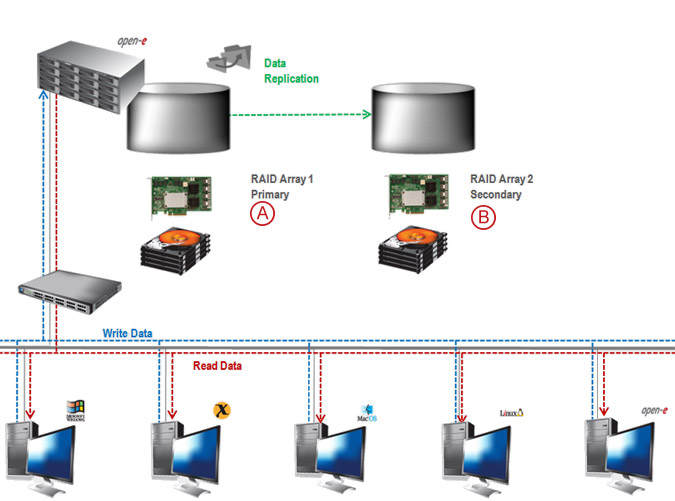
Pic 01
 Data is written and read from Array 1
Data is written and read from Array 1
 Data is periodically replicated to Array 2
Data is periodically replicated to Array 2
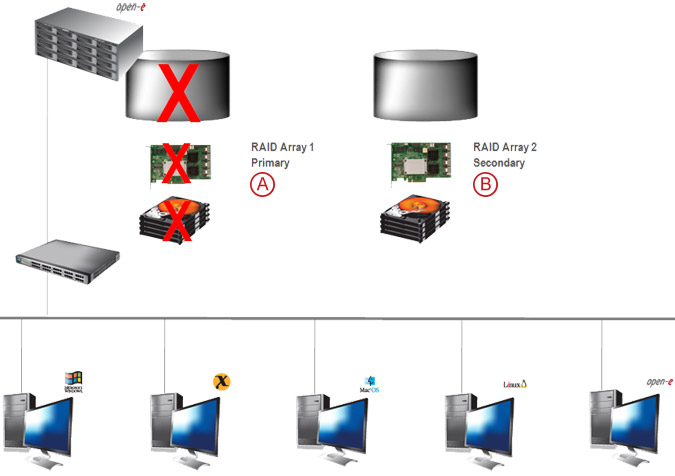
Pic 02
 In case of raid array error or disk drive error on the Raid Array 1, the server will send an e-mail notification to the administrator and/or users
In case of raid array error or disk drive error on the Raid Array 1, the server will send an e-mail notification to the administrator and/or users
 The administrator then switches from Array 1 to Array 2
The administrator then switches from Array 1 to Array 2
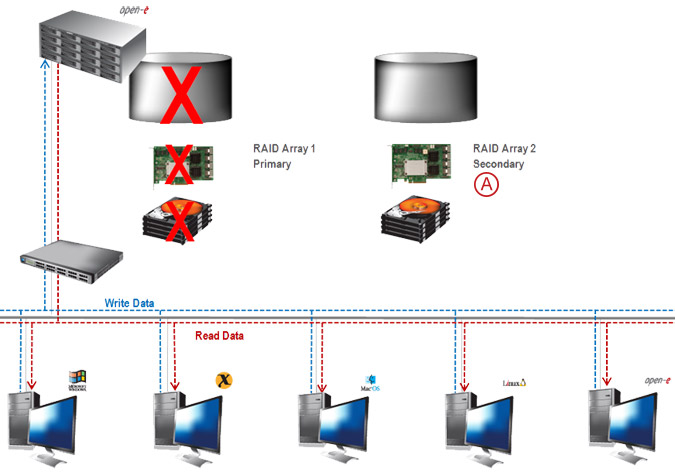
Pic 03
 After switching, replicated data is available on Array 2
After switching, replicated data is available on Array 2
top ↑2.2. Asynchronous Data Replication over a LAN
Replication between two systems within a single LAN
- Recommended Resources
- Key Hardware (two systems)
- x86 compatible
- RAID Controller
- HDD's
- Network Interface Cards
- Software
- Open-E DSS, 2 units
- Key Hardware (two systems)
- Benefits
- Data redundancy over a LAN
- Local data availability
- Disadvantages
- Natural disasters can destroy both machines
- High cost of solution
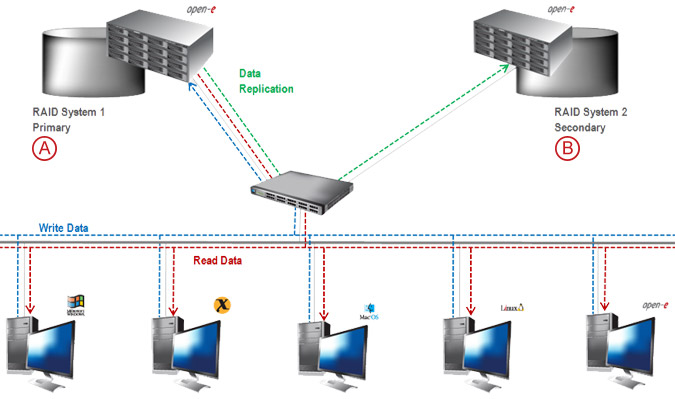
Pic 04
 Data is written and read in System 1
Data is written and read in System 1
 Data is periodically replicated from System 1 to System 2 over the LAN
Data is periodically replicated from System 1 to System 2 over the LAN
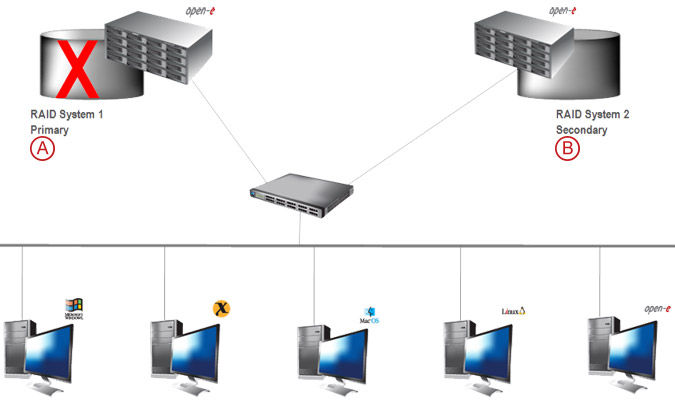
Pic 05
 In case of raid array error, or disk drive error on System 1, the system will send an e-mail notification to the administrator
In case of raid array error, or disk drive error on System 1, the system will send an e-mail notification to the administrator
 Administrator then switches users to System 2
Administrator then switches users to System 2
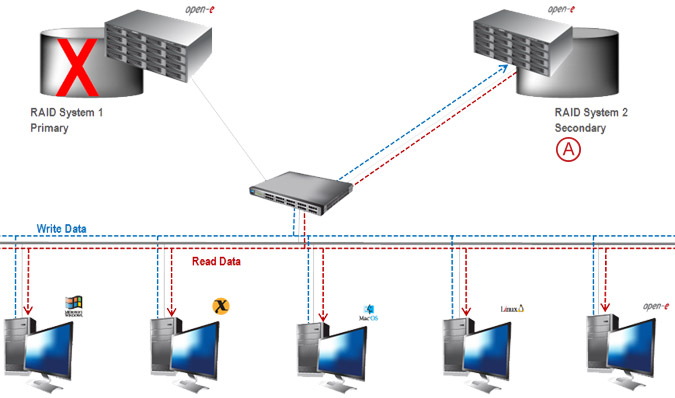
Pic 06
 After switching, replicated data is available on System 2
After switching, replicated data is available on System 2
top ↑2.3. Asynchronous Data Replication over a WAN
Replication between two systems over a WAN
- Recommended Resources
- Key Hardware (two systems)
- x86 compatible
- RAID Controller
- HDD's
- Network Interface Cards
- Software
- Open-E DSS, 2 units
- Key Hardware (two systems)
- Benefits
- Data redundancy
- Maximum data safety
- Disadvantages
- High cost of WAN solution
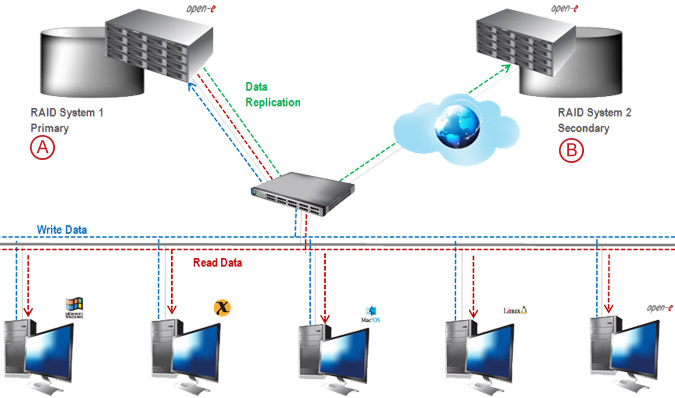
Pic 07
 Data is written and read in System 1
Data is written and read in System 1
 Data is periodically replicated to System 2 via an Internet connection
Data is periodically replicated to System 2 via an Internet connection
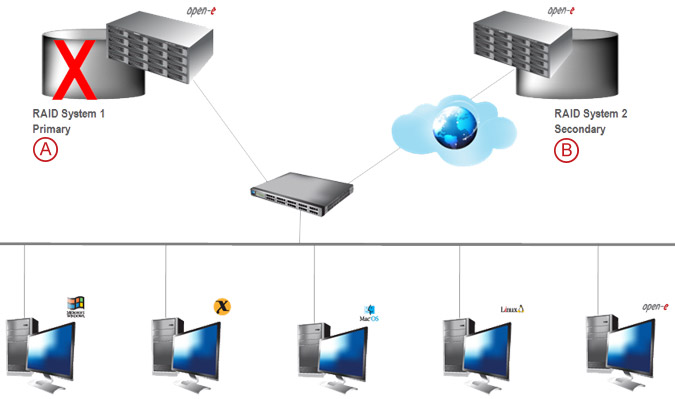
Pic 08
 In the event of a raid array error or disk drive error on System 1, the server will send an e-mail notification to the administrator, In the event of a loss of system 1 users will be notified,
In the event of a raid array error or disk drive error on System 1, the server will send an e-mail notification to the administrator, In the event of a loss of system 1 users will be notified,
 Administrator then switches users to System 2 over the WAN.
Administrator then switches users to System 2 over the WAN.
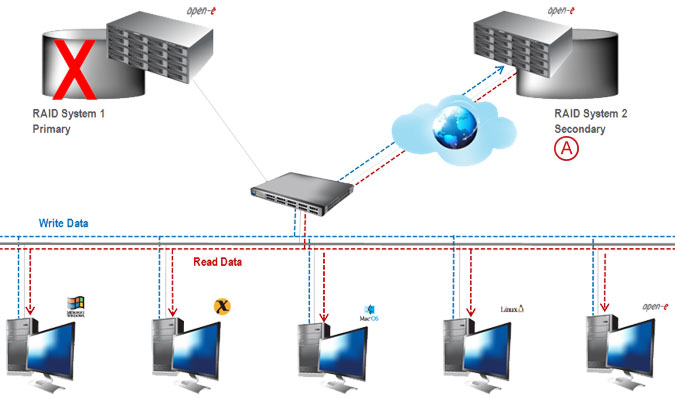
Pic 09
 After switching, replicated data is available on System 2
After switching, replicated data is available on System 2
top ↑3. Volume Replications - Replication Solutions Supported by Open-E DSS
| Replication Mode | Source/Destination | Data Transfer | Volume Type | ||||||||
| Synchro -nous | Asynchro -nous | w/ System | LAN | WAN | File based | Block based | NAS | iSCSI | FC | ||
| File-IO | Block-IO | ||||||||||
| Synchronous Volume Replication over a LAN | |||||||||||
| Synchronous Volume Replication over a WAN | |||||||||||
| Synchronous Volume Replication with Failover over a LAN | |||||||||||
Volume Replication (synchronous) over LAN or WAN is block based and supports iSCSI, FC and NAS logical volumes. It provides data availability in case the source system is offline from a disaster and the destination will have the replicated data of the source server.
Volume Replication with Auto Failover is a fault tolerance process via iSCSI Volume Replication, that creates mirrored target data volumes.
- Data is copied in real-time.
- Every change is immediately mirrored on the secondary storage server.
- In case of a failure, scheduled maintenance of the primary server, or loss of the primary data source, failover automatically switches operations to the secondary storage server, so all processes can be continued as usual.
top ↑3.1. Synchronous Volume Replication over a LAN
Replication between two systems within one LAN
- Recommended Resources
- Key Hardware (two systems)
- x86 compatible
- RAID Controller
- HDD's
- Network Interface Cards
- Software
- Open-E DSS, 2 units
- Key Hardware (two systems)
- Benefits
- Data Redundancy over a LAN,
- Enables continuous data access
- Disadvantages
- High cost of solution,
- Natural disasters can destroy local systems.
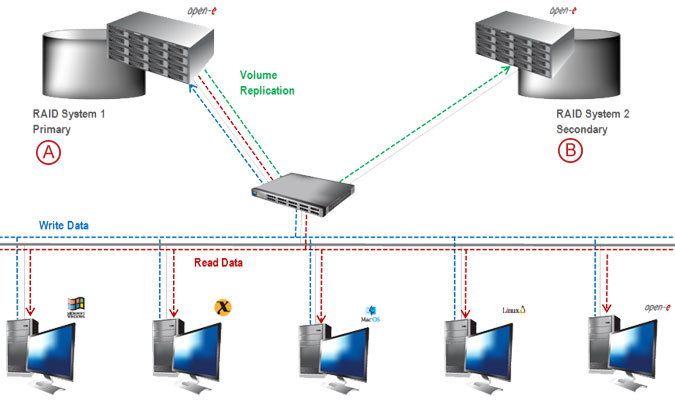
Pic 10
 Data is written and read to System 1
Data is written and read to System 1
 Data is continiously replicated to System 2
Data is continiously replicated to System 2
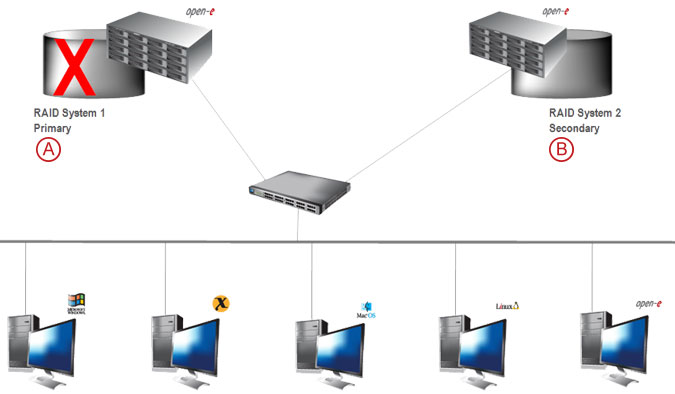
Pic 11
 In case of raid array error or disk drive error on the System 1, the server will send an e-mail notification to the administrator, In the case of a failure of system 1, users will be notified,
In case of raid array error or disk drive error on the System 1, the server will send an e-mail notification to the administrator, In the case of a failure of system 1, users will be notified,
 Administrator then switches users to the System 2
Administrator then switches users to the System 2
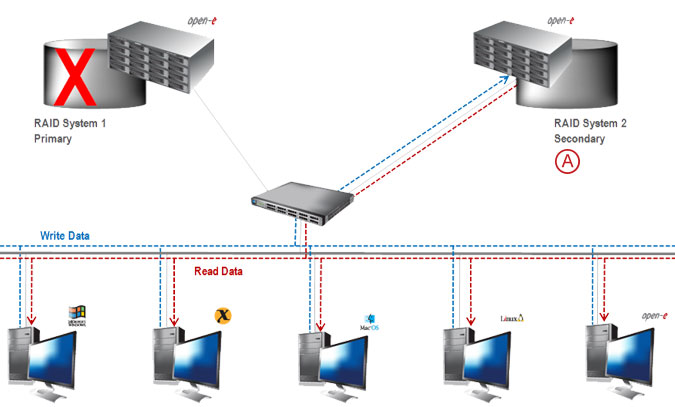
Pic 12
 After switching, replicated volume is available on System 2
After switching, replicated volume is available on System 2
top ↑3.2. Synchronous Volume Replication over a WAN
Replication between two systems over a WAN
- Recommended Resources
- Key Hardware (two systems)
- x86 compatible
- RAID Controller
- HDD's
- Network Interface Cards
- Software
- Open-E DSS, 2 units
- Key Hardware (two systems)
- Benefits
- Data redundancy
- Maximum data safety
- Disadvantages
- High cost of WAN solution
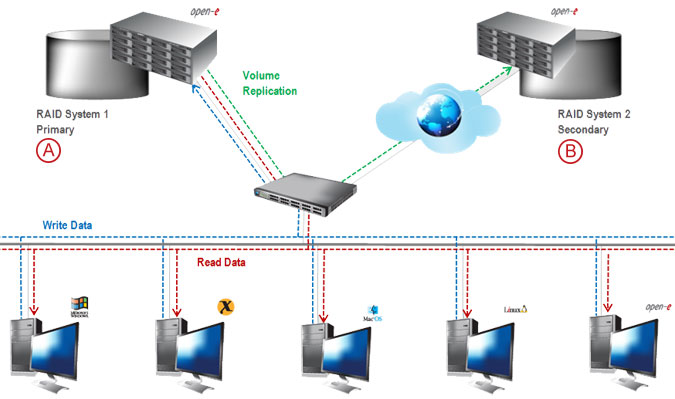
Pic 13
 Data is written and read to System 1
Data is written and read to System 1
 Data is replicated to System 2 via an Internet connection
Data is replicated to System 2 via an Internet connection
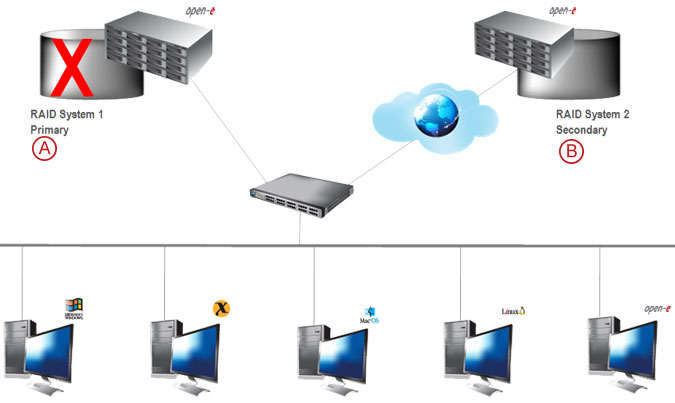
Pic 14
 In case of raid array error or disk drive error on the System 1, the server will send an e-mail notification to the administrator, In the case of a failure of system 1, users will be notified,
In case of raid array error or disk drive error on the System 1, the server will send an e-mail notification to the administrator, In the case of a failure of system 1, users will be notified,
 Administrator then switches users to the System 2 over the WAN.
Administrator then switches users to the System 2 over the WAN.
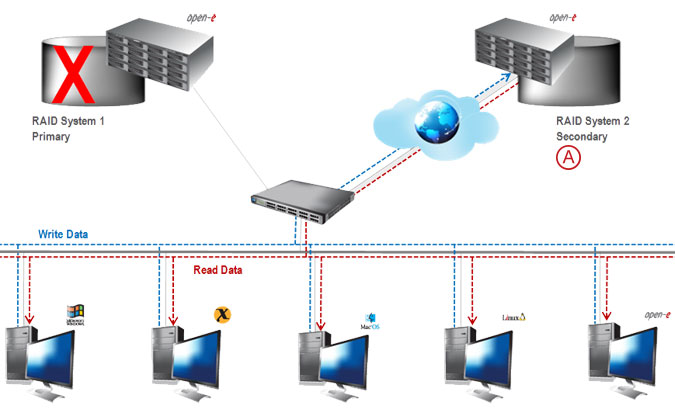
Pic 15
 After switching, replicated volume is available on System 2
After switching, replicated volume is available on System 2
top ↑3.3. Synchronous Volume Replication with Failover over a LAN
Volume Replication with Failover between two systems within one LAN
- Recommended Resources
- Key Hardware (two systems)
- x86 compatible
- RAID Controller with Batery Backup Unit
- HDD's
- Network Interface Cards
- Ping Node (ping node it is any permanently (24/7) available host in the network. In particular case the ping node function can be performed by the server storing the data on the iSCSI failover volume).
- Software
- Open-E DSS, 2 units
- Key Hardware (two systems)
- Benefits
- Eliminates business disruption
- Provides data redundancy over a LAN
- Enables switch redundancy
- Disadvantages
- High cost of solution
- Natural disasters can destroy local systems
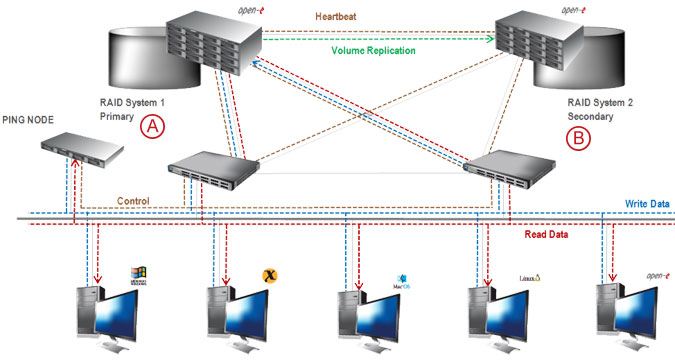
Pic 16
 Data is written and read to System 1 (primary)
Data is written and read to System 1 (primary)
 Data is continually replicated to System 2 (secondary)
Data is continually replicated to System 2 (secondary)
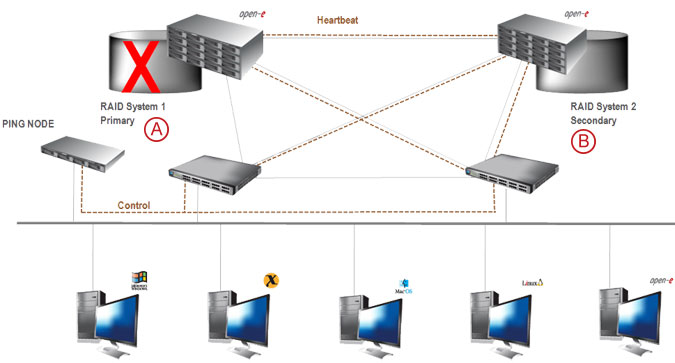
Pic 17
 In case of raid array or disk drive error on System 1 (primary), the server will send an e-mail notification to the administrator. iSCSI Auto Failover determines there is no connection between the servers
In case of raid array or disk drive error on System 1 (primary), the server will send an e-mail notification to the administrator. iSCSI Auto Failover determines there is no connection between the servers
 After a few seconds Automatic Failover is executed and users are switched to System 2 (secondary)
After a few seconds Automatic Failover is executed and users are switched to System 2 (secondary)
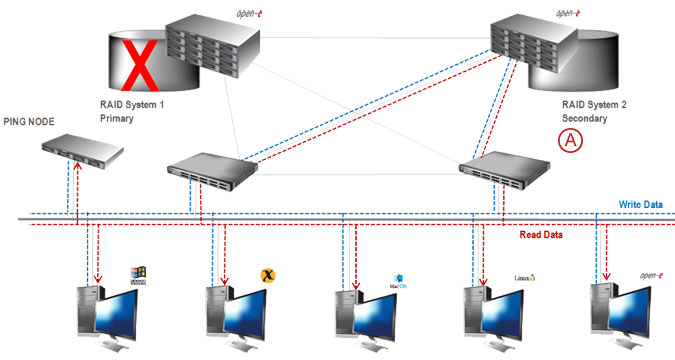
Pic 18
 After switching, the replicated volume is available on System 2 (secondary)
After switching, the replicated volume is available on System 2 (secondary)
